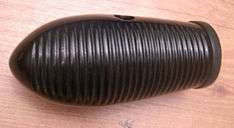Struck idiophone
Struck idiophones is one of the categories of idiophones (that is, any musical instrument that creates sound primarily by the instrument as a whole vibrating—without the use of strings or membranes) that are found in the Hornbostel-Sachs system of musical instrument classification.
Struck idiophones are categorised as 11 in the Hornbostel-Sachs system. There are two main categories of struck idiophones, directly (111) and indirectly (112) struck.
Directly struck (111)
Directly struck idiophones produce sound resulting from a direct action of the performer as opposed to the indirectly struck idiophones. The player strikes the instrument with a direct action, either by hand or by mechanical intermediate devices, beaters, keyboards, or by pulling ropes, etc. It is definitive that the player can apply clearly defined individual strokes and that the instrument itself is equipped for this kind of percussion.
There are two main categories of directly struck idiophones, concussion idiophones (111.1) and percussion idiophones (111.2).
Concussion idiophones or clappers (111.1)
Two or more complementary sonorous parts are struck against each other.
111.11 Concussion sticks or stick clappers (nearly equal thickness and width).
111.12 Concussion plaques or plaque clappers (flat).
111.13 Concussion troughs or trough clappers (shallow).
111.14 Concussion vessels or vessel clappers (deep).
111.141 Castanets - Natural and hollowed-out vessel clappers.
111.142 Cymbals - Vessel clappers with manufactured rim.
- Chap
- Ching
- Clash Cymbals
Percussion idiophones (111.2)
The instrument is struck either with a non-sonorous object (hand, stick, striker) or against a non-sonorous object (human body, the ground).
111.21 Percussion sticks.
111.211 Individual percussion sticks.
111.212 Sets of percussion sticks in a range of different pitches combined into one instrument. - All xylophones, as long as their sounding components are not in two different planes.
- Balafon
- Gandingan a kayo
- Glasschord
- Glass marimba
- Glasspiel/verrillon
- Kulintang a kayo
- Luntang or kwintangan kayo
- Marimba
- Marimbaphone (also bowed)
- Xylophone
- Xylorimba
111.22 Percussion plaques.
111.221 Individual percussion plaques.
111.222 Sets of percussion plaques - Examples are the Lithophone and also most Metallophones.
- Crotales
- Lithophone
- Celesta
- Fangxiang
- Gangsa
- Gendèr
- Glockenspiel
- Kulintang a tiniok, kulintang a putao, or sarunay
- Metallophone
- Ranat ek lek
- Ranat thum lek
- Toy piano
- Ugal
- Vibraphone
111.23 Percussion tubes.
111.231 Individual percussion tubes.
- Agung a tamlang
- Alimba
- Huari
- Huiringua
- Kagul
- Krin or Kolokolos
- Mondo
- Mukoko
- Slit drum
- Takuapu
- Teponaztli
- Tubular Wood block
111.232 Sets of percussion tubes.
- Tubular bells or chimes
111.24 Percussion vessels.
- Boungu
- Chuk
- Cymbals
- Crash cymbal
- Hank drum
- Hi-hat cymbal
- Hang
- Kagul or tagutok
- Ride cymbal
- Slit drums:
- Slit gong
- Splash cymbal
- Steelpan or steel drum
- Udu (also an aerophone)
- Wood block
111.241 Gongs - The vibration is strongest near the vertex.
111.241.1 Individual gongs.
111.241.2 Sets of gongs.
111.242 Bells - The vibration is weakest near the vertex.
111.242.1 Individual bells
111.242.11 Resting bells whose opening faces upward.
111.242.12 Hanging bells suspended from the apex.
111.242.121 Hanging bells without internal strikers.
111.242.122 Hanging bells with internal strikers.
- Bell
111.242.2 Sets of bells or chimes.
111.242.11 Sets of resting bells whose opening faces upward.
111.242.12 Sets of hanging bells suspended from the apex.
111.242.121 Sets of hanging bells without internal strikers.
111.242.122 Sets of hanging bells with internal strikers.
Indirectly struck (112)
Indirectly stuck idiophones produce sound resulting from an indirect action of the performer as opposed to the directly struck idiophones.[1] The player himself does not go through the movement of striking; percussion results indirectly through some other movement by the player. This category is divided in two main sub-categories: shaken idiophones and scraped idiophones.[2]
Shaken idiophones or rattles (112.1)
The player makes a shaking motion
112.11 Suspension rattles - Perforated idiophones are mounted together, and shaken to strike against each other.
112.111 Strung rattles - Rattling objects are strung in rows on a cord.
112.112 Stick rattles - Rattling objects are strung on a bar or ring.
112.12 Frame rattles - Rattling objects are attached to a carrier against which they strike.
112.121 Pendant rattles.
112.122 Sliding rattles.
112.13 Vessel rattles - Rattling objects enclosed in a vessel strike against each other or against the walls of the vessel, or usually against both.
Scraped idiophones (112.2)

The player causes a scraping movement directly or indirectly; a non-sonorous object moves along the notched surface of a sonorous object, to be alternately lifted off the teeth and flicked against them; or an elastic sonorous object moves along the surface of a notched non-sonorous object to cause a series of impacts. This group must not be confused with that of friction idiophones.
112.21 Scraped sticks.
112.211 Scraped sticks without resonator.
112.212 Scraped sticks with resonator.
112.22 Scraped tubes.
112.23 Scraped vessels.
112.24 Scraped wheels - cog rattles or Ratchet
112.3 Split idiophones - Instruments in the shape of two springy arms connected at one end and touching at the other: the arms are forced apart by a little stick, to jungle or vibrate on recoil.
References
- "Idiophone". Music.vt.edu. 2013-05-23. Retrieved 2014-01-03.
- http://www.soundpossibilities.org/html/instruments.html Archived June 27, 2010, at the Wayback Machine